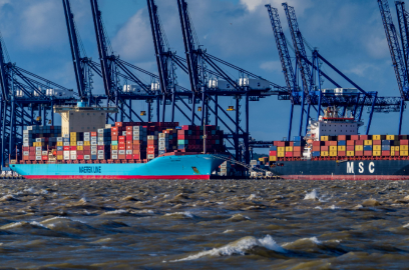Sharing China-Made with Global Customers

The situation in the Red Sea affects global trade. The expanding crisis caused freight rates to skyrocket overnight. According to the latest China Export Container Freight Index released by the Shanghai Shipping Exchange, freight rates in the Asia-Europe shipping market have risen sharply, driving the composite index up 161.47 points to 1254.99 points, an increase of 14.8%. It was the largest weekly gain in nearly seven years.
Affected by the Red Sea crisis, the SCFI container freight index experienced a rare "four consecutive increases" after the epidemic. The increase in this period even exceeded the level during the epidemic. The four major ocean routes rose across the board. The European route can only be described as "surge", while the US route, which was already high, also rose compared with the previous week. Among all routes, the freight rate on the Asia-Europe route has experienced a particularly sharp increase, with a surge of 45.5% and nearly 50% compared with the previous period.
At the same time, freight rates from Asia to the Mediterranean also increased by more than 30% in a single week. Led by European lines, SCFI recorded its largest weekly gain since 2016.
People in the shipping industry pointed out that the current freight rate trend is even more violent than the surge in freight rates caused by the epidemic. This phenomenon highlights the profound impact of the Red Sea crisis on the global shipping market and the market's concerns about the imbalance between supply and demand of shipping capacity.
The latest Drewry World Container Composite Index (WCI) rose by 9%, and the freight rates from Shanghai to Europe and the Mediterranean increased by double digits, rising by 16% and 15% respectively.
The Panama Canal has not yet fully recovered due to the drought crisis caused by natural disasters, and the shipping market has once again been impacted by man-made crisis events. Both factors are increasing the uncertainty in the mass shipping market.
Industry insiders in the freight forwarding industry said that freight volume and prices performed well in January due to the support of the peak shipping season before the Spring Festival. Among them, the prosperity of the US-Western route is due to the fact that the East US is affected by the Panama Canal, and some goods are transferred to the West US. Nowadays, ships heading to the Panama Canal or the Suez Canal have all chosen to bypass the Cape of Good Hope, leading to a large-scale shift in global shipping routes (although Maersk is currently preparing to resume the Red Sea route, most companies still maintain their original plan and continue to increase freight rates).
As the Red Sea crisis escalated sharply, freight rates doubled in just one week, bearing the brunt of the impact on the Asia-Europe route. According to reports, the average freight rate for 40-foot containers has climbed to US$4,000-5,000, a 1.5 times increase from the basic freight rate. At the same time, the weekly increase in 20-foot container freight rates on the Middle East route also reached 25.7%.
This sudden increase in freight rates has put tremendous pressure on those goods that are in urgent need of shipment and have high added value before the Lunar New Year. In order to cope with this challenge, some cargo owners have begun to consider switching from sea transportation to land transportation, air transportation, or sea, land and air combined transportation. According to people in the freight forwarding industry, air freight prices from China to Northern Europe began to rise last week, with an increase of about 10%, while freight rates for China-Europe railways also increased by about US$500.
Looking to the future, in the first half of the year starting from January 1 next year, freight rates on routes to Europe, the United States, and the Middle East are expected to increase across the board. The freight rate per 40-foot container on the European route is expected to increase by about US$2,000, while the freight rate per 40-foot container on routes such as the United States, the Middle East, India and Pakistan, and Africa will also increase by US$1,000.
Industry insiders said that if freight rates continue to rise, cargo owners will inevitably pass on the rising transportation costs to end consumers, which may further push up inflation. The U.S. Federal Maritime Commission (FMC) is already monitoring the situation to understand shipper concerns.
Regarding the observation of freight rate increase and sustainability, many industry insiders believe that there are two key points: first, the development of the situation in the Red Sea, which will continue to affect the efficiency of shipping; second, the order status of Europe and the United States after the Lunar New Year.
